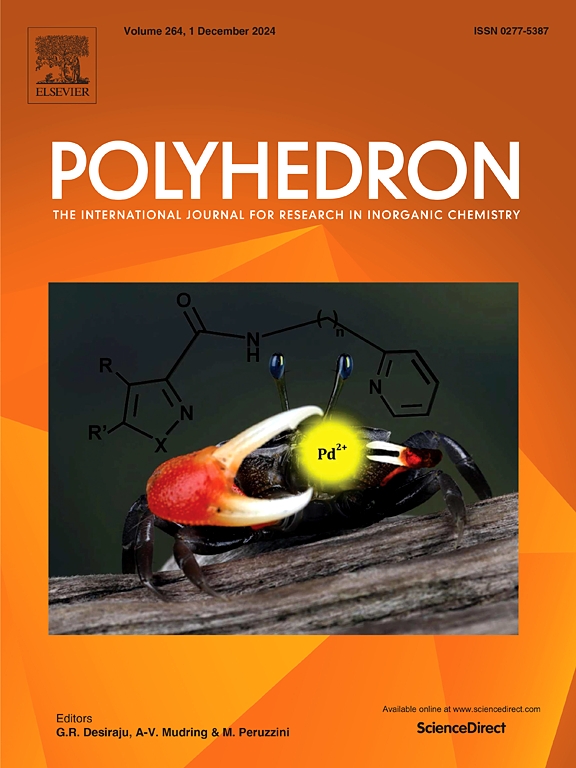Inorganic nanoparticles fabricated in poly(methyl methacrylate-acrylic acid) hydrogels as efficient catalyst for the reduction of dyes: A RSM study
IF 2.4
3区 化学
Q2 CHEMISTRY, INORGANIC & NUCLEAR
引用次数: 0
Abstract
This study investigates the catalytic reduction of Congo red (CR), a harmful anionic diazo dye, using Ag NPs loaded poly(methyl methacrylate-acrylic acid) microgel [PMMA-AAc@MIc)]. Ag-PMMA-AAc@MIc was prepared via free radical precipitation polymerization followed by the fabrication of Ag NPs using an in-situ reduction method. The synthesized PMMA-AAc@MIc and Ag-PMMA-AAc@MIc were characterized through UV–Visible (UV–Vis) spectroscopy, Fourier Transform Infrared (FTIR) spectroscopy, Dynamic light scattering (DLS), Field Emission Scanning Electron Microscopy (FE-SEM), and Thermo-gravimetric Analysis (TGA). The catalytic efficiency of Ag-PMMA-AAc@MIc particles was evaluated by adopting the reduction of CR dye as benchmark reaction. The reduction process was optimized using Response Surface Methodology (RSM) that considered the effects of varying concentrations of CR, NaBH4, and hybrid microgel dosage on the values of percentage reduction of CR. The catalytic performance of Ag-PMMA-AAc@MIc for CR reduction was assessed by recording the UV–Vis spectra. Kinetic studies indicate that reduction reaction follows the pseudo first order kinetic model with a rate constant (kapp) found as 0.336 min−1 for reduction of CR. ANOVA analysis further validated the significance of the quadratic model. The optimized reaction conditions favored the rapid degradation of CR while minimizing the use of NaBH4 and hybrid microgel dose. The catalyst was found efficient for the reduction of CR upon reuse. This research contributes to the development of cost-effective and environmental sustainable catalysts for toxic dye removal from water sources, addressing the urgent need for efficient wastewater treatment.

聚甲基丙烯酸甲酯水凝胶制备的无机纳米颗粒作为染料还原的高效催化剂:RSM研究
本研究研究了用负载Ag NPs的聚(甲基丙烯酸甲酯)微凝胶[PMMA-AAc@MIc]催化还原有害阴离子重氮染料刚果红(CR)。通过自由基沉淀聚合法制备了Ag-PMMA-AAc@MIc,然后采用原位还原法制备了Ag纳米粒子。通过紫外可见光谱(UV-Vis)、傅里叶变换红外光谱(FTIR)、动态光散射(DLS)、场发射扫描电镜(FE-SEM)和热重分析(TGA)对合成的PMMA-AAc@MIc和Ag-PMMA-AAc@MIc进行了表征。以还原CR染料为基准反应,评价Ag-PMMA-AAc@MIc颗粒的催化效率。考虑不同浓度的CR、NaBH4和杂化微凝胶用量对CR还原率的影响,采用响应面法(RSM)对还原工艺进行优化,并通过记录紫外可见光谱来评价Ag-PMMA-AAc@MIc对CR还原的催化性能。动力学研究表明,还原反应符合准一级动力学模型,还原CR的速率常数(kapp)为0.336 min−1,方差分析进一步验证了二次模型的显著性。优化后的反应条件有利于CR的快速降解,同时尽量减少NaBH4的用量和杂化微凝胶的用量。发现该催化剂在重复使用时对CR的减少是有效的。本研究有助于开发具有成本效益和环境可持续性的催化剂,用于从水源中去除有毒染料,解决高效废水处理的迫切需要。
本文章由计算机程序翻译,如有差异,请以英文原文为准。
求助全文
约1分钟内获得全文
求助全文
来源期刊

Polyhedron
化学-晶体学
CiteScore
4.90
自引率
7.70%
发文量
515
审稿时长
2 months
期刊介绍:
Polyhedron publishes original, fundamental, experimental and theoretical work of the highest quality in all the major areas of inorganic chemistry. This includes synthetic chemistry, coordination chemistry, organometallic chemistry, bioinorganic chemistry, and solid-state and materials chemistry.
Papers should be significant pieces of work, and all new compounds must be appropriately characterized. The inclusion of single-crystal X-ray structural data is strongly encouraged, but papers reporting only the X-ray structure determination of a single compound will usually not be considered. Papers on solid-state or materials chemistry will be expected to have a significant molecular chemistry component (such as the synthesis and characterization of the molecular precursors and/or a systematic study of the use of different precursors or reaction conditions) or demonstrate a cutting-edge application (for example inorganic materials for energy applications). Papers dealing only with stability constants are not considered.
 求助内容:
求助内容: 应助结果提醒方式:
应助结果提醒方式:


